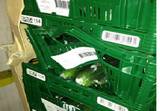Reusable packaging protects best for fruit and veg through supply chain
Around 4% of disposable packaging for fruits and vegetables are damaged on their way to the consumer compared to only 0.1% of reusable packaging, according to a German market analysis.
 The Fraunhofer Institute for Material Flow and Logistics and the Cold-Chain Management Working Group at the University of Bonn investigated the potential link between packaging damage and packaging type in one part of their study.
The Fraunhofer Institute for Material Flow and Logistics and the Cold-Chain Management Working Group at the University of Bonn investigated the potential link between packaging damage and packaging type in one part of their study.
Reusable packaging experiences a significantly lower rate of packaging damage compared to disposable cardboard packaging, said the researchers in the study initiated by Stiftung Initiative Mehrweg (Foundation for Reusable Systems).
The data was collected during from July to August 2012, in three central warehouses belonging to the top five retail groups and one central warehouse belonging to one of the top five discount retail groups.
According to The Asociación de Operadores Logísticos de Elementos Reutilizables Ecosostenibles (ARECO), if the data from the study was applied to Spanish global exports of fresh fruits and vegetables, more than €1.8m could be saved when using just reusable crates and containers.
Reusable packaging was defined in the Germany study as sales, outer or transport packaging that is intended to be reused repeatedly for containing, protecting, handling, supplying or presenting goods.
Disposable packaging fulfils this purpose only once and is then recovered or disposed.
Causes of damage
The main causes of packaging damage in reusable packaging were inadequate securing of loading units and improper handling.
Disposable packaging damage to cardboard boxes were insufficiently robust packaging, inconsistent dimensions and a lack of compatibility with other packaging.
The researchers used two scenarios to apply the results to the current market situation: the first scenario assumes that disposable packaging is used exclusively across the entire supply chain, while the second scenario involves the exclusive use of reusable packaging.
Scenario one found that by the end of the supply chain, around 45 million packaging units per year will be damaged so around 36,000 tonnes of fruit and vegetables are damaged each year which equals a loss of some €68m.
Scenario two highlighted that by the end of the supply chain, around 1.4 million packaging units per year will be damaged. Leading to 1.1 thousand tonnes of fruit and vegetables being damaged per year and equalling a loss of around €2m.
Out of 37,577 disposable types of packaging, 309 (0.82%) were reported as damaged compared to 40, 576 of reusable packages only nine (0.02%) were damaged.
Corrugated cardboard made up 84% of the disposable packaging units with a damage rate of 0.71% and solid cardboard was a 9% proportion with 2.46% damage rate.
Damage in warehouse
In the central warehouse insufficiently robust packaging, inadequate securing of loading units and outside influences were three causes of damage.
Insufficiently robust packaging is that which is unable to support loads stacked on top of it and inadequate securing of loading units covers damage caused by loading units that are insufficiently or incorrectly secured (by means of stretch film or straps).
Outside influences occur when damage to the packaging stems from incorrect or improper handling or from negligence, such as damage during unloading from the lorry or caused by forklift prongs; mistakes made during the formation of the loading unit (excessive length); or incorrect securing of load within the lorry.
A total of 78,153 transport packaging units were examined. 52% were reusable and 48% were disposable.
Bananas, raspberries, apricots, oranges, limes, physalis, pineapples, mangoes, grapefruit, kiwi fruit and papaya all use 100% disposable corrugated cardboard for the proportion of the packaging used for the product.
Avocados, peas, sweet corn, spinach and loose leaf lettuce were the vegetables that used disposable corrugated cardboard for the proportion of the packaging used for the product.

































